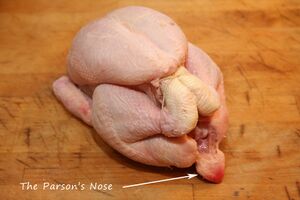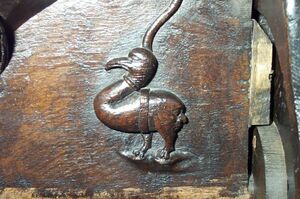-
The Parson's nose
-
The Parson's nose, removed
-
Carving on the stalls, St Mary's Church, Nantwich
The Pope's nose, parson's nose or sultan's nose is the pygostlye, a fleshy protuberance at the rear end of a bird (usually chicken, duck or turkey in culinary usage). The pygostyle is the final few vertebrae, fused together during birds evolution.
The pygostyle also contains the uropygial gland that produces the oil the the bird uses to preen itself with.
Culinary use
Heston Blumenthal in common with many cooks, specifies that the parsons nose should always be removed before cooking as it is likely to make the dish greasy or even bitter.
The parson's nose should be removed when the bird is being dressed (trimmed and prepared for cooking).
I have seen it mentioned throughout the Internet that some consider the parson's nose to be a delicacy, though I can find no further verification of this.
Etymology
"Pygostyle" is of Ancient Greek origin, literally meaning "rump pillar".
The phrase "parson's nose", from the notion that an English parson may 'have his nose in the air', upturned like the chicken's rear end. The term must have been known as early as around 1400 AD, when a carpenter had been contracted to provide new choir stalls for St Mary's Church, Nantwich. The vicar was either slow to pay the artisan, or did not pay at all. In retaliation, on the last misericord in the stalls, the carpenter carved a bird with an image of that Vicar's face with protuberant nose as rump. The carving is still visible today and featured on a postcard on sale at the church.
A similar derivation applies to the phrase "Pope's nose", which may have originated as a derogatory term meant to demean Catholics in England during the late 17th century.
"Sultan's nose" probably was coined some time during the Early Modern era wars against the Ottoman Empire.
Discover Cookipedia's Culinary Creations on Pinterest
Explore the vibrant world of Cookipedia through our Pinterest page! We've curated a stunning collection of recipes that highlight the beauty of home-cooked dishes. It's the perfect way to visually navigate our extensive recipe library and get inspired by the flavours we’ve shared over the years. Dive in and discover your next favorite meal—one picture at a time!


